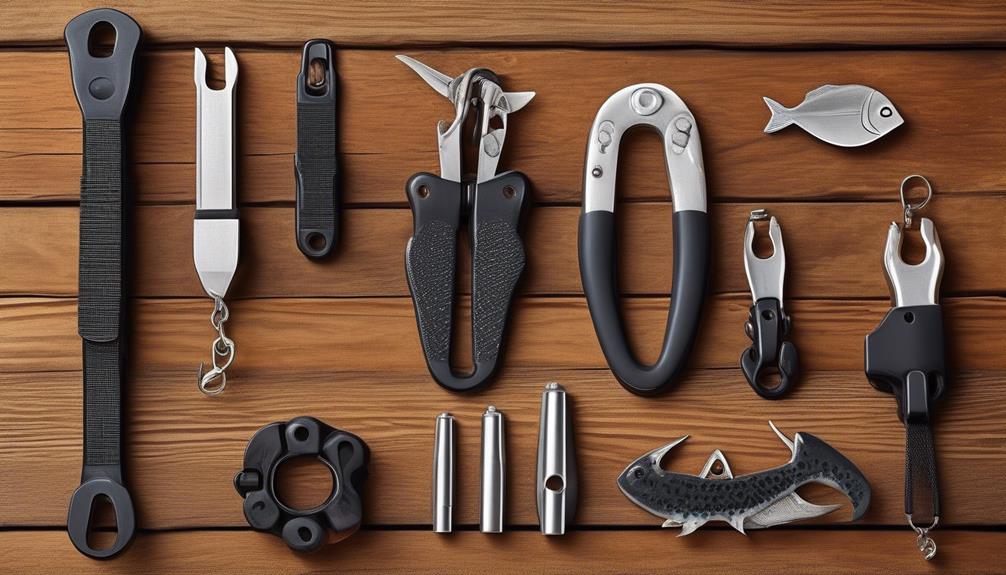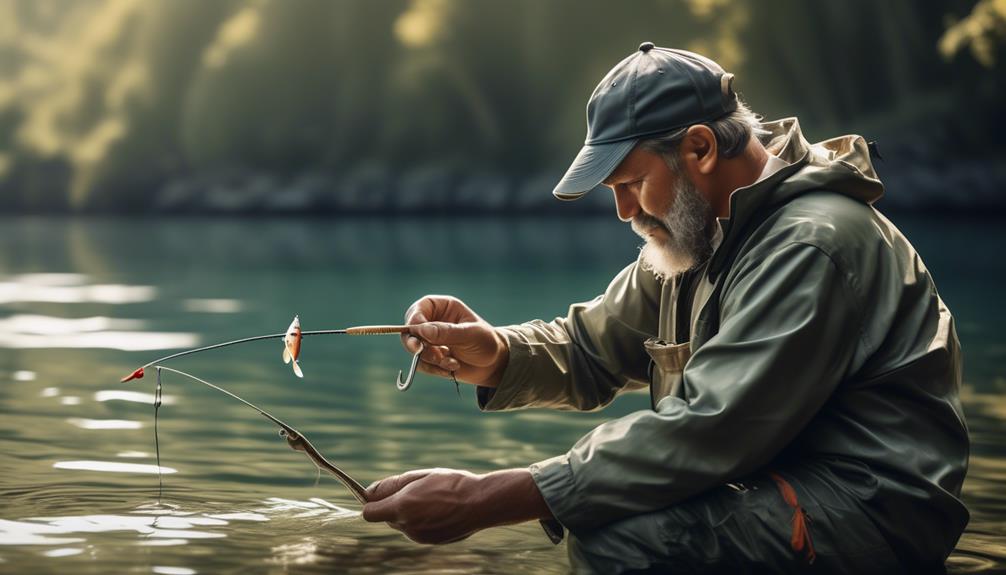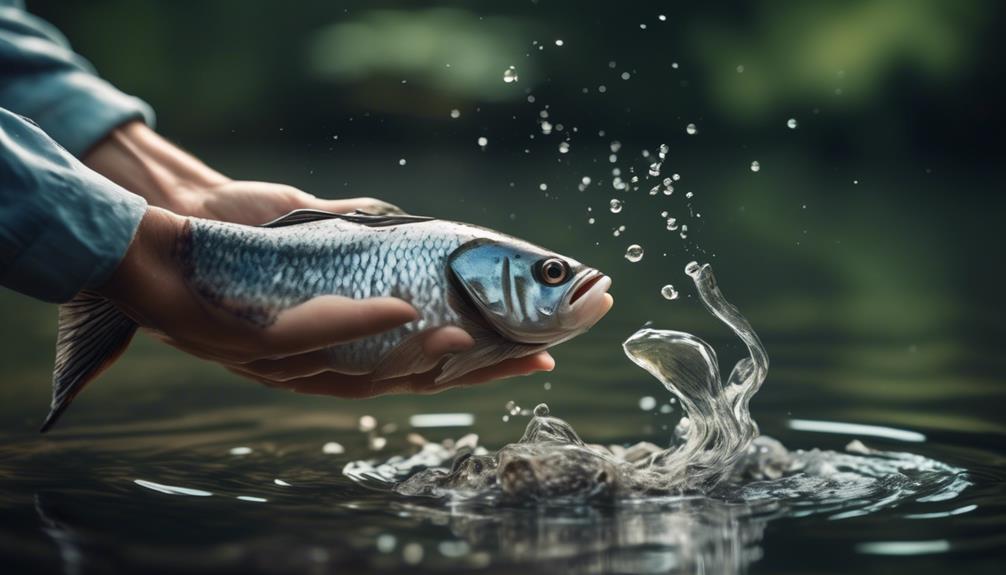You know the saying, 'A bad workman blames his tools'? When it comes to catch and release angling, having the right gear can make all the difference.
From the right fishing rod to the most suitable hooks and nets, your choices can impact the well-being of the fish you catch.
But how do you know which gear is truly the best for catch and release angling? There are key factors to consider that can make your angling experience more effective and ethical.
Fishing Rods
When choosing fishing rods for catch and release angling, prioritize lightweight and flexible options to enhance your angling experience while minimizing harm to the fish. Consider rod materials and durability when making your selection. Look for rods made from durable materials such as graphite, fiberglass, or a combination of both. These materials offer the strength needed to handle a variety of fish species while maintaining the flexibility required for successful catch and release angling. Additionally, these materials contribute to the overall lightweight nature of the rod, reducing fatigue during extended fishing trips.
Rod action and sensitivity are crucial factors to consider when selecting a fishing rod for catch and release angling. Opt for a rod with the right action, which refers to the flexibility of the rod and how it responds to pressure. Fast action rods bend mostly at the tip, providing increased sensitivity and allowing for quick hook sets, while moderate action rods bend more towards the middle, making them more forgiving and ideal for handling larger fish. A sensitive rod tip is essential for detecting subtle strikes, minimizing the risk of deep hook sets and maximizing the chances of safely releasing the fish.
Reels
To enhance your catch and release angling experience, prioritize selecting a lightweight and durable reel that offers smooth casting and retrieval. When it comes to reel maintenance, choosing the right reel for the job is crucial. Look for reels with a sealed drag system to prevent water and dirt from affecting the performance. Regular maintenance, such as cleaning and lubricating the reel, will ensure its longevity and optimal performance.
Selecting the right reel for the job depends on the type of fishing you plan to do. For lighter freshwater fishing, a spinning reel may be more suitable, while for heavier saltwater fishing, a baitcasting reel with a strong drag system is essential. Consider the fish species you're targeting and the fishing environment to make an informed decision.
Understanding reel drag systems is also important for successful catch and release angling. Different drag systems, such as front drag and rear drag, offer varying levels of smoothness and adjustability. This can make a significant difference when playing a fish, especially when aiming for a successful release.
In addition to maintenance and selecting the right reel, mastering casting techniques is crucial. Practice different casting methods to improve accuracy and distance. Understanding how to adjust the reel's settings for different casting techniques will enhance your overall angling experience.
Lines
Mastering casting techniques is crucial for a successful catch and release angling experience, and the choice of lines plays a vital role in achieving this goal. When selecting lines for catch and release angling, it's essential to consider factors such as line strength, durability, visibility, and sensitivity.
Line strength and durability are crucial for withstanding the strain of reeling in various fish species. Look for lines that offer high tensile strength and are resistant to abrasion, ensuring they can handle the rigors of angling without compromising performance.
In addition to strength and durability, line visibility is an important consideration, especially in clear waters or when fishing in bright conditions. Opt for lines that are low-visibility or come in natural colors to minimize the chances of startling the fish. This can improve your chances of a successful catch.
Furthermore, line sensitivity is key to detecting subtle strikes and bites. Choose lines that offer excellent sensitivity, allowing you to feel even the slightest movements underwater. This heightened sensitivity can significantly improve your ability to detect when a fish has taken the bait, increasing your overall catch rate.
Hooks
Consider selecting hooks designed specifically for catch and release angling to minimize harm to the fish. When choosing hooks for catch and release fishing, it's important to consider hook sizes and barbless options. Using smaller hook sizes can reduce the damage to the fish's mouth, making it easier for them to recover after being released. Barbless hooks are also beneficial as they cause less trauma to the fish and make hook removal safer and quicker, improving the chances of survival upon release.
It's essential to consider the environmental impact and ethical considerations when selecting hooks for catch and release angling. Using barbless hooks can significantly reduce the injury and stress on the fish, aligning with ethical angling practices and ensuring the fish's well-being. Additionally, opting for barbless hooks reduces the risk of causing harm to other wildlife if the hook is accidentally lost or left behind in the water.
When purchasing hooks for catch and release fishing, look for options that are specifically designed for this purpose. Many manufacturers offer barbless hook varieties in a range of sizes, catering to different types of fish and fishing techniques. By choosing hooks that prioritize the well-being of the fish and the environment, you can enjoy the sport of angling while minimizing harm to aquatic life.
Nets
When selecting a net for catch and release angling, prioritize using a soft, knotless mesh material to minimize damage to the fish. This is crucial for the well-being of the fish you intend to release. Consider the following when choosing a net:
- Material: Opt for a net made of rubber or silicone-coated nylon to ensure it's gentle on the fish's scales and slime coat. Avoid nets with rough or abrasive textures that can harm the fish.
- Size: Choose a net that's appropriately sized for the species you're targeting. A larger net may be necessary for bigger fish, but be mindful not to use an excessively large net as it can cause unnecessary stress and injury to the fish.
- Handle: Look for a net with a handle that's long enough to comfortably reach the water from your fishing position. An extendable handle can be convenient for various angling situations, allowing you to maintain a safe distance from the fish while landing it.
When it comes to the environmental impact and ethical practices, using a net with a soft, knotless mesh material and the right size and handle can contribute to the well-being of the fish and the sustainability of the angling environment. By being mindful of the gear you use, you can ensure that your catch and release practices are as ethical and environmentally friendly as possible.
Pliers
When handling your catch for release, the right pair of pliers can be essential for safely removing hooks without causing unnecessary harm to the fish. Look for pliers specifically designed for hook removal, with slim, serrated jaws that can grip the hook securely. The best pliers will have a non-slip grip, ensuring that you can handle them easily, even with wet hands. Additionally, consider pliers made from materials that resist rust and corrosion, such as stainless steel or aluminum, to ensure longevity and rust prevention in harsh marine environments.
When it comes to hook removal, having a good pair of pliers can make the task much easier and less stressful for both you and the fish. The slim, serrated jaws of these specialized pliers allow for precise gripping and maneuvering, minimizing the risk of causing additional injury to the fish during the hook removal process. Furthermore, the rust prevention properties of materials like stainless steel or aluminum ensure that your pliers remain reliable and corrosion-free, even after prolonged exposure to saltwater.
Fish Grippers

A reliable fish gripper can provide a secure and humane way to handle and release your catch without causing unnecessary harm. When choosing a fish gripper, consider the following key factors:
- Grip Strength: Look for a gripper with a sturdy and reliable grip. The gripper should be able to firmly hold onto the fish without causing any damage to its mouth or body. A strong grip ensures that you can safely handle the fish while minimizing stress and potential injuries to the fish.
- Durability: Opt for a fish gripper that's made of high-quality, durable materials. It should be able to withstand the rigors of angling and the elements. A durable gripper will last longer and can be used for multiple fishing trips, reducing the need for frequent replacements and contributing to fish conservation efforts.
- Fish Conservation: Choose a fish gripper that aligns with principles of fish conservation. A good gripper should be designed to minimize harm to the fish, allowing for a quick and easy release. This helps to promote the survival of the fish after being caught and ensures that future generations of fish can thrive in their natural habitats.
Selecting a fish gripper with strong grip strength, durability, and a focus on fish conservation won't only enhance your catch and release angling experience but also contribute to the overall well-being of fish populations.
Proper Handling Techniques
Considering the importance of handling the catch with care, it's crucial to understand proper handling techniques when practicing catch and release angling. Fish behavior plays a significant role in their survival post-release. When handling a fish, it's important to minimize their time out of the water. Keep the fish in the water as much as possible, only lifting it out for a quick photo before gently releasing it. Be mindful of the fish's body language – if it's struggling or showing signs of distress, release it immediately.
Conservation tips also play a vital role in proper handling. Always wet your hands before handling a fish. This helps protect their delicate skin and scales. Avoid using towels or dry hands as they can remove the protective slime layer, leaving the fish vulnerable to infection. Additionally, avoid squeezing the fish tightly or placing excessive pressure on its body. Support the fish under its belly and, if necessary, gently hold its tail.
When handling larger fish, it's essential to provide proper support. Never lift a fish by its gills, jaw, or eyes, as this can cause serious injury. Instead, use both hands to support its body, keeping it horizontal to avoid spine damage. Finally, if the fish is hooked deeply, consider cutting the line instead of trying to remove the hook, as this can cause unnecessary harm.
Frequently Asked Questions
What Are the Best Types of Lures or Baits to Use for Catch and Release Fishing?
When it comes to catch and release fishing, the best artificial and live bait options are those that minimize harm to the fish. Artificial lures like barbless hooks and soft plastics are great choices as they reduce hooking injuries.
For live bait, consider using circle hooks to minimize deep hooking.
Additionally, practicing proper fish handling techniques, such as keeping the fish in the water as much as possible, can help ensure a successful catch and release.
How Can I Properly Revive a Fish Before Releasing It Back Into the Water?
To properly revive a fish before releasing it back into the water, gently cradle the fish in the water and move it back and forth to allow water to flow through its gills. Support the fish until it swims away on its own.
Proper revival techniques are essential for fish conservation and to ensure their survival after catch and release. Remember to handle the fish with care to minimize stress and maximize its chances of recovery.
Are There Any Specific Regulations or Guidelines for Catch and Release Fishing in My Area?
Before heading out for catch and release fishing, it's crucial to know the specific regulations and guidelines for your area. These rules are put in place to support conservation efforts and minimize the environmental impact of angling.
Check for area-specific rules about catch and release, such as size limits, barbless hooks, and proper handling techniques.
Staying informed and following these guidelines will help ensure the sustainability of fish populations and their habitats.
What Is the Best Way to Ensure the Safety and Health of the Fish During the Release Process?
To ensure the safety and health of the fish during the release process, focus on gentle fish handling and stress reduction. Use barbless hooks for easy removal and minimize the time the fish is out of the water. Consider using tools like hemostats for hook removal.
For underwater release, gently hold the fish facing into the current until it swims away on its own. These practices help to minimize harm and increase the chances of survival for the released fish.
Are There Any Specific Techniques or Strategies for Targeting Certain Species of Fish for Catch and Release Angling?
When targeting specific species for catch and release angling, it's important to use proper angling techniques and select the right lure and bait choices. Understanding catch and release strategies, following local regulations, and prioritizing fish safety and health are crucial.
As an angler, it's your responsibility to ensure the proper revival of the fish before releasing them back into the water. By adhering to these practices, you can contribute to the conservation of fish populations.
Conclusion
So there you have it – with the right gear and techniques, you can enjoy catch and release angling while minimizing harm to the fish.
Remember to invest in a quality fishing rod, reel, and line, and use barbless hooks to make releasing the fish easier.
Always handle the fish with care and consider using tools like nets, pliers, and fish grippers to ensure a safe and successful release.
Happy angling!



